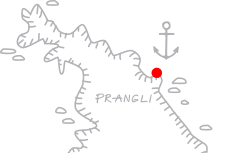History
- Prangli Island was inhabited already in the prehistoric times, as the first residents were fishermen and sealers
- Mentioned for the first time in 1387, under the name of Rango
- Prangli Island and other places of North-Estonia were inhabited by Swedes between the 12th and 14th centuries
- Many legends of Prangli Island as the island of pirates date back to the Middle Ages
- In the 19th century, many of the islanders were engaged in smuggling (salt, matches, coffee, spirits, tar)
- In the 20th century, the main activity of the islanders was fishing (Baltic herring, Atlantic herring, cod), after the First World War, also the spirit smuggling
- A fishing kolkhoz called Noor Kaardivägi was established on the island of Prangli in 1949 and in 1961, it became the department of Prangli of the Kirov kolkhoz.
- Historical names of the island: Wrangö, Wrängo, Wrangelsöm, Wrangelsholm, Wranjö, Wranger, Gross-Wrangelsholm, Rangelus, Rangi
Geography
- Area, 6.44 km2
- Coastline, 26.4 km
- Distance from the mainland
- Nearby are the islands of Aksi, Keri, Tiirloo and Seinakari
- A number of small bays and capes on the eastern coast (Liivaneem, Koistu Cape, Ülesaare Cape)
- The highest areas are Punane kivi (the Red Stone) and Kullamägi, both about 10 metres
Population
- Population, 174 (as at 1 January 2017)
- The island has three villages: Lääneotsa, Idaotsa and Kelnase
Nature
- The entire island of Prangli is a landscape protection area
- The island grows 455 species of native plants and 70 species of cultivated plants
- 30% of the island are covered by forest
- The most common type of tree on the island is pine
- The most numerous mammals: the fox, rabbit, water vole, rat and mouse
- The island has a lot of erratic boulders, the largest of them, Punane kivi (the Red Stone), is with dimensions of a giant boulder
- The island is covered with marine sand and coarse gravel
- The relief of the landscape is flat and gentle
- Natural gas has been found in many parts of the island, the reserves of which, however, are not so high to worthwhile the excavation
Leisure activities
Class trips to Prangli Island. Prangli Reisid invites school pupils to exciting daytrips or multi-day tours. We organise tours to Prangli Island and Lahemaa and seal watching tours near the Malusi Islands. We can organise recreation activities for the children and catering and, if necessary, also bus transportation and accommodation.
Seal watching tours near the Malusi Islands. The Baltic Sea has been home for seals for about 10,000 years, and they are the biggest water mammals in this region. The seal watching tours take place in summer and autumn, when the seal pups have already grown bigger, and know how to swim. The duration of the boat trip is 2-3 hours out of which the seal watching lasts about an hour, the rest of the time is spent sailing to the archipelago. The tours take place in Estonian and/or English.
Kayaking tour to Kolga Bay Islands. The trip starts from Kaberneeme harbour from where we row over Koipsi and Rammu to Aksi wherefrom you can go to the island of Keri. If you do not want to go to Keri, you can move on to Prangli. The price includes equipment, hiking food and a tour guide. Kayaking experience is required.
Aksi is a small island near Prangli Island. Aksi was once inhabited by known boat builders, the Aksberg family. People do not live there now; however, the foundations are reminiscent of the great buildings. Natura 2000 bird protection area is located on the island of Aksi.



